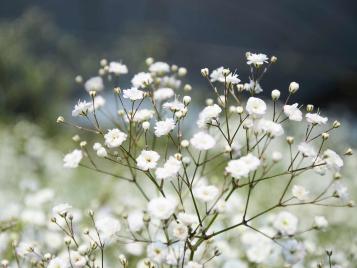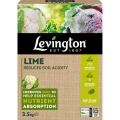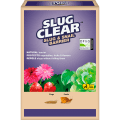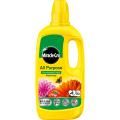

How to grow Gypsophila (baby’s breath)
Known as ‘baby’s breath’, Gypsophila has earned its nickname from the sweet-sour milk smell of its flowers, which resemble that of baby’s breath. It has a dainty appearance and is often used in traditional flower arrangements and bridal bouquets to bring softness to the arrangement. This softness also works beautifully in the garden, making it perfect for adding a graceful aesthetic to flower beds.
Types of Gypsophila to grow
There are about 150 species of Gypsophila, some of which are annuals and some that are perennials.
Gypsohpila paniculata is a perennial variety and one of the tallest types, reaching just under 1m (3') tall. The following cultivars are worth considering:
- ‘Bristol Fairy’. An unusually tall Gypsophila, reaching over 1m (up to 4') in height.
- ‘Flamingo’. Double pale-pink flowers borne on slender stems.
- ‘Perfect Alba’. Grey-green foliage and pure white flowers which bloom in late summer.
- ‘Rosenschleier’. One of the most widely regarded cultivars of perennial baby’s breath, much shorter than others, reaching just 30cm (1') tall. It has double white flowers which fade to pale-pink as they mature.
Gypsophila elegans is an annual type of baby’s breath, with dainty flowers and foliage. Cultivars which we recommend include:
- ‘Covent Garden’. White flowers and light green-grey coloured foliage.
- ‘Kermesina’. Great for pollinators, a very dark pink star-shaped flower.
- ‘Rosea’. Flowers of rose-pink colour.
Gypsophila muralis is a low-growing, bushy annual which is great at the front of a border, or in containers and hanging baskets. Two particularly attractive varieties are:
- ‘Gypsy Deep Rose’. Densely arranged deep pink flowers.
- ‘Gypsy Pink’. Intricate foliage and flowers which will appeal to pollinators over a long flowering season.
Gypsophila saxifraga is a hardy perennial alpine type, remaining evergreen in mild areas. It is perfect for a spot where it can cascade over the sides of a container, wall or green roof.
What you’ll need to grow Gypsophila
To grow annual Gypsophila from seed, you will need:
- Gloves.
- Miracle-Gro® Peat Free Premium All Purpose Compost.
- Garden rake.
- Watering can.
- Gypsophila seeds.
- SlugClear™ Slug & Snail Barrier.
- Levington® Lime.
To grow perennial and alpine Gypsophila from cuttings, you will need:
- Gloves.
- Horticultural grit.
- Garden trowel.
- Watering can.
- Gypsophila plants.
- Miracle-Gro® Peat Free Premium Border Booster Soil Improver.
- SlugClear™ Slug & Snail Barrier.
- Levington® Lime.
Where to plant and place your Gypsophila
Gypsophila are perfect grown alongside other plants, where their thin and sparse stems contrast well with larger clumping and densely growing plants. They do need room to spread, so make sure they won’t crowd out other smaller plants. Gypsophila do not like cold, wet soil, so avoid locations which are slow to warm up.

When to plant your Gypsophila
Perennial varieties of Gypsophila can be propagated through basal cuttings, and alpine varieties should be divided in early spring. Annual Gypsophila should be sown in their final growing position from April - June, or September. For an ongoing flush of flowers throughout the summer, sow annual varieties every couple of weeks during the spring.
How to sow Gypsophila
Always wear gloves when handling compost, seeds and plants. Annual, alpine and perennial Gypsophila are all best planted in their final positions, as they do not like root disturbance.
All need well-drained and slightly alkaline soil, so add horticultural grit and Levington® Lime to the soil in the autumn, before sowing or planting out the following year.
For annual Gypsophila grown from seed, use a garden rake to work the soil surface to a fine tilth. Use the watering can to wet the soil, sprinkle seeds over the soil surface, and then sprinkle some Miracle-Gro® Peat Free Premium All Purpose Compost mixed with the soil. Seeds will germinate, grow and flower in the same season.
For alpine and perennial Gypsophila grown from plants, use the garden spade to dig a hole slightly larger than the rootball. Place the plant in the soil so that the rootball is slightly below the surface, backfill with soil and gently firm in around the plant. Water well after planting.
Keep seeds and plants well watered, and protect young plants with SlugClear™ Slug & Snail Barrier.
Caring and nurturing your Gypsophila
Light: Provide Gypsophila with plenty of direct sunlight, ensuring that other nearby plants do not overshadow them. Aim to ensure they receive six hours or more each day.
Watering: do not allow soil to become waterlogged. Gypsophila prefer dry conditions if anything, so err on the side of caution when it comes to watering.
Soil
Gypsophila prefer alkaline to neutral soil, and will not grow well in acidic soil. Add Levington® Lime to the soil surface annually in the late autumn to maintain optimum soil conditions. Avoid planting in clay soils which are prone to water retention, and instead aim for a sandy, well-drained location.
Temperature and humidity
Flowers will die-back in cold weather, but Gypsophila are perennials or hardy annuals and the plants should survive frosts.
Fertilising
Feed monthly during the growing season with Miracle-Gro® Premium All Purpose Continuous Release Plant Food.
Pruning
Remove Gypsophila flowers which are past their best, as this deadheading will encourage new flowers to develop. Throughout the flowering season, cut 5-6 stems to bring into the home fresh, or more for drying and using throughout the year.
Propagating
Sow annual varieties from seed, divide alpine varieties, and take cuttings of perennial varieties, as detailed above.
Common pests and diseases with Gypsophila
What are the slimy trails on my plant and surrounding soil?
Slugs and snails love Gypsophila, and will devour new green growth. Use SlugClear™ Slug & Snail Barrier and see Love The Garden’s useful guide to tackling this common pest.
What are the groups of tiny insects on my Gypsophila?
Aphids are familiar to all gardeners, with their telltale call signs of sticky honeydew excretions and black sooty mold growths nearby. Squish populations by hand, and apply BugClear™ Ultra 2 or use the BugClear™ Fruit & Veg Ultra to tackle large infestations.
What has eaten the tips of the foliage of my Gypsophila?
Rabbits love munching on the young foliage of baby’s breath, and can be very destructive. Keep them from your garden with fencing.
What is the white and yellow mottling on the leaves of my Gypsophila?
Leafhoppers suck sap from the foliage of many different plants, weakening them and stunting future growth. Hold a sticky sheet of card above the plant, gently shake the plant, and allow leafhoppers to stick themselves to the card, which you can then dispose of. Repeat daily until under control.
Frequently asked questions about Gypsophila
Can I use Gypsophila as a cut flower?
Yes - Gypsophila is a florists’ go-to flower for weddings and other celebrations. Use them fresh or dried as part of a Gypsophila bouquet, a buttonhole, in hair pins and crowns, corsages or wreaths.
Is baby’s breath invasive?
Gypsophila paniculata is considered invasive in some parts of the world, because it competes with native plants. However, in the UK this is rarely a problem, and the plant is easily dug out when it starts to outgrow its place in the border.
Is Gypsophila available in any colours other than pink or white?
There are very deep pink coloured baby’s breath, verging on purple and some a shade of rose red.
Can I grow Gypsophila in pots?
It’s possible to grow most plants in pots, but not always recommended. A lot of effort can be spent trying to meet the needs of the plants, when really it’s much happier grown in the ground. Gypsophila is one of those plants.
Is Gypsophila poisonous?
Gypsophila is toxic to cats and dogs, and humans can have an allergic reaction to it too. Always wear gloves when handling any part of the plant, and wash your hands thoroughly afterwards.
Key features of Gypsophila
| Botanical Name | Gypsophila spp. |
|---|---|
| Plant Type | Annual or perennial |
| Family | Caryophyllaceae |
| Light Exposure | Full sun |
| Soil pH | Alkaline to neutral |
| Flowering Time | July - August |
| Flower Colour | White or pink |




